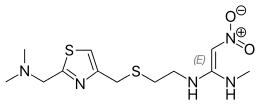Nizatidine
Nizatidine is a histamine H2 receptor antagonist that inhibits stomach acid production, and is commonly used in the treatment of peptic ulcer disease and gastroesophageal reflux disease.[1]
 | |
| Clinical data | |
|---|---|
| Trade names | Axid, Tazac |
| AHFS/Drugs.com | Monograph |
| MedlinePlus | a694030 |
| License data |
|
| Pregnancy category |
|
| Routes of administration | By mouth |
| ATC code | |
| Legal status | |
| Legal status | |
| Pharmacokinetic data | |
| Bioavailability | >70% |
| Protein binding | 35% |
| Metabolism | Liver |
| Elimination half-life | 1–2 hours |
| Excretion | Kidney |
| Identifiers | |
| |
| CAS Number | |
| PubChem CID | |
| IUPHAR/BPS | |
| DrugBank | |
| ChemSpider | |
| UNII | |
| KEGG | |
| ChEBI | |
| ChEMBL | |
| CompTox Dashboard (EPA) | |
| ECHA InfoCard | 100.155.683 |
| Chemical and physical data | |
| Formula | C12H21N5O2S2 |
| Molar mass | 331.45 g·mol−1 |
| 3D model (JSmol) | |
| |
| |
| | |
It was patented in 1980 and approved for medical use in 1988.[2][3] It was developed by Eli Lilly. Brand names include Tazac and Axid.
Medical use
Nizatidine is used to treat duodenal ulcers, gastric ulcers, and gastroesophageal reflux disease (GERD/GORD), and to prevent stress ulcers.[4]
Adverse effects
Side effects are uncommon, usually minor, and include diarrhea, constipation, fatigue, drowsiness, headache, and muscle aches.[4]
History and development
Nizatidine was developed by Eli Lilly, and was first marketed in 1988.[2] It is considered to be equipotent with ranitidine and differs by the substitution of a thiazole ring in place of the furan ring in ranitidine. In September 2000, Eli Lilly announced they would sell the sales and marketing rights for Axid to Reliant Pharmaceuticals.[5] Subsequently, Reliant developed the oral solution of Axid, marketing this in 2004, after gaining approval from the U.S. Food and Drug Administration (FDA).[6] However, a year later, they sold rights of the Axid Oral Solution (including the issued patent[7] protecting the product) to Braintree Laboratories.[8]
Nizatidine proved to be the last new histamine H2 receptor antagonist introduced prior to the advent of proton pump inhibitors.
See also
- Famotidine (Pepcid) — another popular H2 receptor antagonist
References
- Romero M, Franzosi MG (1989). "[Nizatidine]". Medicina (Florence, Italy) (in Italian). 9 (1): 93–6. PMID 2567957.
- "Nizatidine: FDA-Approved Drugs". U.S. Food and Drug Administration (FDA). Retrieved 20 March 2020.
- Fischer J, Ganellin CR (2006). Analogue-based Drug Discovery. John Wiley & Sons. p. 44. ISBN 9783527607495.
- "Nizatidine". LiverTox: Clinical and Research Information on Drug-Induced Liver Injury. NCBI Bookshelf. 25 January 2018. PMID 31643707. NBK548387. Retrieved 19 March 2020.
- "Eli Lilly and Company and Reliant Pharmaceuticals Announce Agreement for U.S. Sales and Marketing Rights to Axid(R)". High Beam Encyclopedia. 7 September 2000. Archived from the original on May 26, 2008.
- "Reliant Pharmaceuticals to Launch AxidŽ Oral Solution". Reliant Pharmaceuticals, LLC. 26 July 2004.
- US 6930119, Bobotas G, Fawzy AA, "Liquid pharmaceutical composition", issued 24 June 2005, assigned to Reliant Pharmaceuticals, LLC
- "Reliant Pharmaceuticals Announces the Sale of Axid® Oral Solution to Braintree Laboratories". Reliant Pharmaceuticals, LLC. Archived from the original on August 14, 2007.